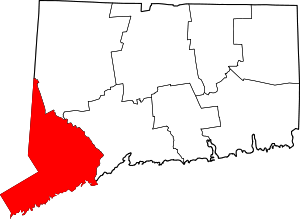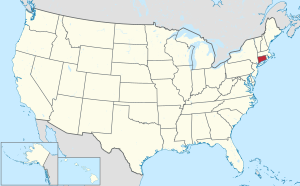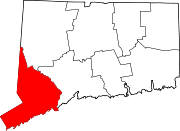|
Fairfield County, Connecticut
Fairfield County is a county in the southwestern corner of the U.S. state of Connecticut. It is the most populous county in the state and was also its fastest-growing from 2010 to 2020. As of the 2020 census, the county's population was 957,419,[1] representing 26.6% of Connecticut's overall population. The closest to the center of the New York metropolitan area, the county contains four of the state's seven largest cities—Bridgeport (first), Stamford (second), Norwalk (sixth) and Danbury (seventh)—whose combined population of 433,368 is nearly half the county's total population. The United States Office of Management and Budget has designated Fairfield County as the Bridgeport–Stamford–Norwalk metropolitan statistical area.[2] The United States Census Bureau ranked the metropolitan area as the 59th most populous metropolitan statistical area of the United States in 2019. The U.S. Office of Management and Budget has further designated the metropolitan statistical area as a component of the more extensive New York–Newark–Bridgeport, NY–NJ–CT–PA combined statistical area,[2] the most populous combined statistical area and primary statistical area of the United States.[3] As is the case with all eight of Connecticut's counties, there is no county government and no county seat. As an area, it is only a geographical point of reference. In Connecticut, the cities and towns are responsible for all local governmental activities including fire and rescue, schools, and snow removal; in a few cases, neighboring towns will share certain resources. The last county seat was Bridgeport, which had served this role from 1853 until 1960.[4] On June 6, 2022, the U.S. Census Bureau formally recognized Connecticut's nine councils of governments as county equivalents instead of the state's eight counties. Connecticut's eight historical counties continue to exist in name only, and are no longer considered for statistical purposes.[5] Fairfield County's Gold Coast helped rank it sixth in the U.S. in per-capita personal income by the Bureau of Economic Analysis in 2005,[6] contributing substantially to Connecticut being one of the most affluent states in the U.S.[7] Other communities are more densely populated and economically diverse than the affluent areas for which the county is better known. HistoryFairfield County was the home of many Native American tribes prior to the Europeans' arrival. People of the Schaghticoke tribe lived in the area of present-day New Fairfield and Sherman.[8] From east to west the Wappinger sachemships included the Paugussetts, Tankiteke, and the Siwanoy. There were also Paquioque and Potatuck inhabitants of Fairfield County. The Dutch explorer Adriaen Block explored coastal Connecticut in the Spring and early Summer of 1614 in the North America-built vessel Onrust. The first European settlers of the county, however, were Puritans and Congregationalists from England. Roger Ludlow (1590–1664), one of the founders of the Colony of Connecticut, helped to purchase and charter the towns of Fairfield (1639) and Norwalk (purchased 1640, chartered as a town in 1651).[9] Ludlow is credited as having chosen the name Fairfield. Fairfield is a descriptive name referring to the beauty of its fields.[10] The town of Stratford was settled in 1639 as well by Adam Blakeman (1596–1665). William Beardsley (1605–1661) was also one of the first settlers of Stratford in 1639. Fairfield County was established by an act of the Connecticut General Court in Hartford along with Hartford County, New Haven County, and New London County; which were the first four Connecticut counties, on May 10, 1666. From transcriptions of the Connecticut Colonial Records for that day:
The original Fairfield County consisted of the towns of Rye, Greenwich, Stamford, Norwalk, Fairfield, and Stratford. In 1673, the town of Woodbury was incorporated and added to Fairfield County. In 1683, New York and Connecticut reached a final agreement regarding their common border. This resulted in the cession of the town of Rye and all claims to the Oblong to New York. From the late 17th to early 18th centuries, several new towns were incorporated in western Connecticut and added to Fairfield County, namely Danbury (1687), Ridgefield (1709), Newtown (1711), and New Fairfield (1740). In 1751, Litchfield County was constituted, taking over the town of Woodbury. The final boundary adjustment to Fairfield County occurred in 1788 when the town of Brookfield was incorporated from parts of Newtown, Danbury, and New Milford, with Fairfield County gaining territory from Litchfield County. Other early county inhabitants include:
 During the Revolutionary War, Connecticut's prodigious agricultural output led to it being known informally as "the Provisions State".[12] In the spring of 1777, the British Commander-in-Chief, North America General William Howe, in New York City, ordered William Tryon to interrupt the flow of supplies from Connecticut that were reaching the Continental Army. Tryon and Henry Duncan led a fleet of 26 ships carrying 2,000 men to Westport's Compo Beach to raid Continental Army supply depots in Danbury on April 22, 1777. American Major General David Wooster (1710–1777), who was born in Stratford, was in charge of the stores at Danbury and defended them with a force of only 700 troops. Two years later during a British raid on Greenwich on February 26, 1779 General Israel Putnam, who had stayed at Knapp's Tavern the previous night, rode away on his horse to warn the people of Stamford. Putnam was shot at by the British raiders but was able to escape. The hat he was wearing with a musket ball hole in it is on display at Knapp's Tavern in Greenwich (which is commonly, albeit somewhat erroneously, called Putnam's cottage).[13] In the summer of 1779, General William Tryon sought to punish Americans by attacking civilian targets in coastal Connecticut with a force of about 2,600 British troops. New Haven was raided on July 5, Fairfield was raided on the 7th and burned. Norwalk was raided on July 10 and burned on the 11th. Norwalk militia leader Captain Stephen Betts put up resistance to the invaders, but was overwhelmed by the powerful British raiders and was forced to retreat. 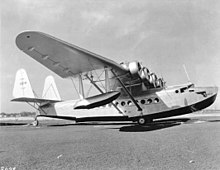 David Sherman Boardman (1786–1864) was a prominent early lawyer and judge in this and neighboring Litchfield County. On October 7, 1801, Neheemiah Dodge and other members of the Danbury Baptist Association wrote a letter to then-president Thomas Jefferson expressing their concern that as Baptists they may not be able to express full religious liberty in the state of Connecticut whose "ancient charter" was adopted before the establishment of a Baptist church in the state. Jefferson replied in a letter to Dodge and the other members of the Danbury church on January 1, 1802, in which he stated that the First Amendment to the United States Constitution provided "a wall of separation between church and State" that protected them.[14] An agricultural region, the first railroad was the Housatonic Railroad, construction started 1836 and ended 1840, extending from Bridgeport to New Milford originally, connecting Litchfield County crops to the port in Bridgeport, by passing New York City.[15] The New York and New Haven railroad along the county's coast was constructed in the late 1840s, which started in New York City and ended in New Haven, connecting Bridgeport, Stamford, Norwalk and all the towns on the coast.[16] In 1851, the county seat of Fairfield County was moved from the town of Fairfield to the newly founded neighboring city of Bridgeport. This was due to its growing population and industry as the old courthouse erected 1794 was no longer adequate.[17] The first hospital in the county, and the 3rd hospital in Connecticut behind Hartford and New Haven Hospitals, Bridgeport Hospital was founded in 1884 along with Fairfield County's first nursing school. It would be soon followed by Danbury Hospital (1885), Norwalk Hospital (1893),[18] Stamford Hospital (1896) [19] Greenwich Hospital (1903),[20]St. Vincent's Hospital in Bridgeport (1903), and Park City Hospital in Bridgeport (1926), which closed in 1993.[21][22][23] By 1900, the largest cities in the county were Bridgeport, Norwalk, Danbury, Stamford and Greenwich.[24] By 1905, Bridgeport had become the principle manufacturing center in the state, and one of the major manufacturers in the New England region behind Boston, Providence, and Worcester, with $44,586,519 total worth of products manufactured without adjusting to today's money.[25] Stamford and Greenwich had become popular resort towns for New York City's wealthy.[26] Connecticut in 1905 was 11th in the United States terms of industrial goods produced, and Fairfield County contained the city with the most total worth of products made, Bridgeport. One-fifth of Connecticut's population was employed in manufacturing, the state's largest industry which generated most of its wealth. Bridgeport in 1905 produced 20% of America's corsets. The 2nd largest city in Connecticut behind New Haven by 1910, Bridgeport's population grew by 50,000 people during the first 20 months of US involvement during the First World War, producing 50% of Allied ammunition during that time.[27] Bridgeport by 1920 had a population of 143,555 people, then the 44th largest US city. Danbury, in northern Fairfield County, was known as the "Hat City", producing 20% of America's hats, until the industry began to decline in the 1920s. Stamford (population 40,067 in 1920), was known as the "Lock City", as the home of the Yale and Towne Lock Manufacturing Company.[16][28][29][30] Bridgeport, nicknamed "Park City" had in 1930 over 500 factories within its borders. Bridgeport Machines, Inc., a milling machine manufacturer, was founded in Bridgeport in 1938, as well as Hubbell Incorporated in the 1890s, these are two examples, various companies were headquartered in Bridgeport, such as Warnerco, ACME Shear, Westinghouse subsidiary Bryant Electric among others, and others such as Remington Arms, General Electric, Singer Sewing Machines, Sikorsky Aircraft, Carpenter Steel, and countless others, had large scale manufacturing complexes there.[31] Most of the county remained agricultural. Westport in the 1920s was a bohemian summer artist colony, and was home to famous artists, writers, and painters, such as F. Scott Fitzgerald, who spent a summer in town. The Cos Cob art colony flourished from the late 1800s to the 1920s.[32][33] At the height of its influence in the 1920s, the Ku Klux Klan had a distinct presence in the county and county politics. The group was most active in Darien, but had small chapters in Norwalk, Stamford, and Bridgeport.[34] The Klan has since disappeared from the county. The county's first institution of higher learning was Western Connecticut State University, founded in Danbury in 1903 (known by its acronym, WCSU),[35] followed by the University of Bridgeport in 1927, Fairfield University in neighboring Fairfield in 1947 and Sacred Heart University.[36] Nearly one-third of Fairfield County's population lived within Bridgeport's city limits in 1950, 31.5%. The city began to decline in population as families moved into nearby suburbs, such as Fairfield, leading to widespread residential development. Bridgeport slowly began to loose jobs and large corporations moved into southern states or outside the country. The city gained a reputation for having an aging industrial image, what New York Times articles described as a smokestack filled, aging view of the city from the highway.[37][38] The Connecticut Turnpike (Interstate 95) was built in the mid-1950s along the coast, joining the scenic Merrit Parkway, built in the late 1930s to alleviate traffic on the Post Road, and built further inland away from population centers.[39] Towns such as Westport, Darien, New Caanan, Stamford, and Greenwich became New York City suburbs, forming the Connecticut Gold Coast,[40][41] Fairfield County, along with all other Connecticut counties, was abolished as a governmental agency in accord with state legislation that took effect October 1, 1960.[42] The first enclosed shopping malls in Fairfield County were Trumbull Shopping Park (1963), in the bedroom community of Trumbull just outside Bridgeport, the now gone Lafayette Shopping Park (1965) in Bridgeport,[37] replaced downtown blocks that were demolished as part of the city's urban renewal, Danbury Fair Mall (1968) on the former fairgrounds of the annual Danbury Fair,[43] Hawley Lane Mallin Trumbull (1971) and the Stamford Town Center (1982) as part of the urban renewal project in downtown Stamford.[44] Stamford, Connecticut, is an example of edge cityurbanization. Stamford in the 1960s was a residential suburb of New York City, with a few industries and research laboratories, but of Stamford's downtown was razed and rebuilt it with modern skyscrapers, and several major corporations moved their headquarters to Stamford, creating one of the largest corporate concentrations in the United States.[16] Originally a more moderate plan, entire downtown blocks and streets were demolished in slow phases and replaced with office towers, residential towers and the Stamford Town Center shopping mall courtesy of the F.D. Rich Company, which was hired by the city to redevelop what was described as the aging, deteriorating downtown, throughout the 60s, 70s and early 80s.[45][43] Stamford's population grew from 92,713 in 1960 to 135,470 people in 2020, making it the 2nd largest city in Connecticut in 2022 (behind Bridgeport), surpassing New Haven.[46][47] GeographyLand   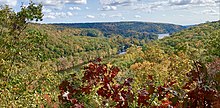 According to the United States Census Bureau, the county has a total area of 837 square miles (2,170 km2), of which 625 square miles (1,620 km2) is land and 212 square miles (550 km2) (25.3%) is water.[48] The terrain of the county trends from flat near the coast to hilly and higher near its northern extremity. The highest elevation is 1,290 feet (390 m) above sea level along the New York state line south of Branch Hill in the Town of Sherman; the lowest point is sea level itself. The Taconic Mountains and the Berkshire Mountains ranges of the Appalachian Mountains run through Fairfield County. The Taconics begin roughly in Ridgefield and the Berkshires begin roughly in Northern Trumbull, both running north to Litchfield County and beyond. A portion of the Taconics also is in rural Greenwich and rural North Stamford in Fairfield County and run north into Westchester County, New York, eventually re-entering Fairfield County in Ridgefield. A small portion of the Appalachian Trail runs through Fairfield County; the trail enters Connecticut in the northernmost and least populous town in the county, Sherman, and moves east into Litchfield County, which encompasses the majority of the Appalachian Trail in Connecticut. The section of the Taconic Mountains range that runs through Greenwich and North Stamford of Fairfield County is also the part of the Appalachians that is closest to the coast out of the entire Appalachian Mountains. WaterThe agreed 1684 territorial limits of the county are defined as 20 miles (32 km) east of New York's Hudson River, which extends into Long Island Sound with a southerly limit of halfway to Long Island, New York. The eastern limit is mostly a natural border defined as the halfway point of the Housatonic River with New Haven County with the exception of several islands belonging wholly to Stratford. The depth of the Sound varies between 60 and 120 feet (37 m). The county hosts or contains the rivers Byram, Housatonic, Mianus, Mill, Norwalk, Pequonnock, Rippowam, Saugatuck, and Still. PollutionThe Still River is polluted with mercury nitrate from the hat industry in Danbury, also thereafter diluting into the Housatonic River and Long Island Sound.[49][50][better source needed] The Housatonic is residually polluted with Monsanto chemicals called Aroclor, polychlorinated biphenyls, or PCBs. From c. 1932 until 1977, the river received PCB pollution discharges from the General Electric plant at Pittsfield, Massachusetts.[51] Mountains and summitsRefer to List of Mountains and Summits in Fairfield County, Connecticut. Adjacent counties
National protected areasMajor highways
ClimateFairfield County has a hot-summer humid continental climate (Dfa) which borders a humid subtropical climate (Cfa) along Long Island Sound. The hardiness zone is 6b in the north and 7a within ten miles of the coast except for areas of Greenwich and Stamford along the coast which are 7b. [1]
See or edit raw graph data.
Demographics
2000 censusAs of the census of 2000, there were 882,567 people, 324,232 households, and 228,259 families residing in the county. The population density was 1,410 inhabitants per square mile (540/km2). There were 339,466 housing units at an average density of 542 per square mile (209/km2). The racial makeup of the county was 79.31% White, 10.01% Black or African American, 0.20% Native American, 3.25% Asian, 0.04% Pacific Islander, 4.70% from other races, and 2.49% from two or more races. 11.88% of the population were Hispanic or Latino of any race. 17.6% were of Italian, 12.4% Irish, 6.5% German and 6.4% English ancestry. In 2010, 66.2% of Fairfield County's population was non-Hispanic whites and 10.8% of the population was black. Asians were 4.6% of the population. Hispanics now constituted 16.9% of the population.[61] As of 2000, 76.2% spoke English, 11.0% Spanish, 2.0% Portuguese, 1.7% Italian and 1.1% French as their first language. Some of the last group were Haitians, although other Haitians would identify Haitian Creole as their first language. There were 324,232 households, out of which 34.20% had children under the age of 18 living with them, 55.50% were married couples living together, 11.50% had a female householder with no husband present, and 29.60% were non-families. 24.00% of all households were made up of individuals, and 9.40% had someone living alone who was 65 years of age or older. The average household size was 2.67 and the average family size was 3.18. In the county, the population was spread out, with 25.60% under the age of 18, 7.00% from 18 to 24, 30.90% from 25 to 44, 23.30% from 45 to 64, and 13.30% who were 65 years of age or older. The median age was 37 years. For every 100 females, there were 93.40 males. For every 100 females age 18 and over, there were 89.60 males. The median income for a household in the county was $65,249, and the median income for a family was $77,690. Males had a median income of $51,996 versus $37,108 for females. The per capita income for the county was $38,350. About 5.00% of families and 6.90% of the population were below the poverty line, including 8.30% of those under age 18 and 6.60% of those age 65 or over. 2010 censusAs of the 2010 United States census, there were 916,829 people, 335,545 households, and 232,896 families residing in the county.[62] The population density was 1,467.2 inhabitants per square mile (566.5/km2). There were 361,221 housing units at an average density of 578.1 per square mile (223.2/km2).[63] The racial makeup of the county was 74.8% white, 10.8% black or African American, 4.6% Asian, 0.3% American Indian, 6.8% from other races, and 2.6% from two or more races. Those of Hispanic or Latino origin made up 16.9% of the population.[62] In terms of ancestry, 18.1% were Italian, 15.9% were Irish, 9.8% were German, 8.7% were English, 5.5% were Polish, and 2.7% were American.[64] Of the 335,545 households, 36.4% had children under the age of 18 living with them, 53.1% were married couples living together, 12.3% had a female householder with no husband present, 30.6% were non-families, and 24.9% of all households were made up of individuals. The average household size was 2.68 and the average family size was 3.21. The median age was 39.5 years.[62] The median income for a household in the county was $81,268 and the median income for a family was $100,593. Males had a median income of $70,187 versus $50,038 for females. The per capita income for the county was $48,295. About 5.6% of families and 8.0% of the population were below the poverty line, including 9.4% of those under age 18 and 6.4% of those age 65 or over.[65] Demographic breakdown by townIncomeData is from the 2010 United States Census and the 2006–2010 American Community Survey 5-Year Estimates.[66][67]
RaceData is from the 2007–2011 American Community Survey 5-Year Estimates, ACS Demographic and Housing Estimates, "Race alone or in combination with one or more other races."[68]
Economy In the late 1960s and early 1970s, corporations began moving their headquarters to Fairfield County from Manhattan; Thomas J. Lueck of The New York Times said that the trend "permanently decentralized big business in the New York region." During the 1980s many buyouts and reorganizations and an economic recession lead to companies vacating much of the suburban office space in Fairfield County. In 1992 Fairfield County had the headquarters of over 25 major multinational corporations, giving it the third largest concentration of those companies in the United States after New York City and Chicago.[69] Fairfield County is home to a large concentration of hedge funds and private equity firms, with many located along the Gold Coast in places like Greenwich, Stamford, and Westport.[70][71][72] Major hedge funds headquartered in Fairfield County include Bridgewater Associates, AQR Capital, Point72 Asset Management, Lone Pine Capital, Viking Global Investors, and Tudor Investment Corporation. Fairfield County is the top location for aquaculture in the state.[73] Government and municipal servicesAs of 1960, counties in Connecticut do not have any associated county government structure. Thus Fairfield County is only a geographical point of reference. All municipal services are provided by the towns, who sometimes will share certain resources through regionalization. In order to address issues concerning more than one town, several regional agencies that help coordinate the towns for infrastructure, land use, and economic development concerns have been established. Within the geographical area of Fairfield County, the regional agencies are:
County municipal buildingsSeveral former county municipal buildings are used by other state or local agencies, including:
Law enforcementLaw enforcement within the geographic area of the county is provided by the respective town police departments, whereas in other states in the region such as New York and Vermont law enforcement would be provided by the local county sheriff's department. In the less dense areas, such as Sherman, law enforcement is primarily provided by the Connecticut State Police. Prior to 2000, a County Sheriff's Department existed for the purpose of executing judicial warrants, prisoner transport, court security, Bailiff, and county and state executions. These responsibilities have now been taken over by the Connecticut State Marshal System. Some municipalities in the county still maintain a sheriff's department to fill the void of the abolishment of the county sheriff's department, such as the City of Shelton which has established the Shelton Sheriff's Department to carry out warrants in the city. JudicialThe geographic area of the county is served by the three separate judicial districts: Danbury, Stamford-Norwalk, and Fairfield. Each judicial district has a superior court located, respectively, in Danbury, Stamford, and Bridgeport. Each judicial district has one or more geographical area courts ("GA"'s), subdivisions of the judicial districts that handle lesser cases such as criminal misdemeanors, small claims, traffic violations, and other civil actions. Fire protectionFire protection in the county is provided by the towns. Several towns also have fire districts that provide services to a section of the town. Education
Education in the county is usually provided by the town governments. The exceptions are the towns of Redding and Easton at the secondary level, as those two joined to form a regional secondary school district (Region 9). School districts include:[74] K-12:
Secondary: Elementary: Private schools:
Closed schools: Crime rateFairfield County has a low crime index of 2050.2 (per 100,000 citizens) as well as a murder closure rate of over 70%.[75] Several Governmental agencies, as well as private security contractors, have made note of Fairfield's low crime rates and the county currently has 6 cities and towns with a percentile safety index of 90% or higher compared to the rest of the continental United States (based on violent and property crimes).[76] PoliticsAs with neighboring Westchester County, Fairfield County was generally a Republican stronghold for much of the 20th century. Urban municipalities such as Stamford, Norwalk and Bridgeport trended Democratic, while the suburban and rural enclaves tended to lean Republican. However, during the 1990s, these latter areas began to increasingly shift towards Democratic candidates. Today, only Hartford County has a higher concentration of Democratic voters. The last time the county voted for a Republican presidential candidate was in 1992 for George H.W. Bush.
Hospitals
TransportationMass transitWith Interstate 95 and the Merritt Parkway increasingly clogged with traffic, state officials are looking toward mass transit to ease the county's major thoroughfares' traffic burden. New office buildings are being concentrated near railroad stations in Stamford, Bridgeport and other municipalities in the county to allow for more rail commuting. Proximity to Stamford's Metro-North train station was cited by the Royal Bank of Scotland as a key reason for locating its new U.S. headquarters building in downtown Stamford; construction on the office tower started in late 2006. AirWithin Fairfield County there are two regional airports: Igor I. Sikorsky Memorial Airport in Stratford and the Danbury Municipal Airport in Danbury. The county is also served by larger airports such as Bradley International Airport, John F. Kennedy International Airport, LaGuardia Airport, Newark Liberty International Airport, Tweed New Haven Regional Airport, and Westchester County Airport. Bus serviceConnecticut Transit's Stamford division runs local and inter-city buses to the southern part of the county.[78] The Norwalk Transit District serves the Norwalk area in the southern central portion of the county; the Greater Bridgeport Transit Authority serves Bridgeport and eastern Fairfield County; and the Housatonic Area Regional Transit agency serves Danbury and the northern portions of the county. Ferry serviceThe Bridgeport & Port Jefferson Ferry carries passengers and cars from Bridgeport to Port Jefferson, New York, across Long Island Sound. Ferry lines in and out of Stamford are also in development. RailCommuter Rail is perhaps Fairfield County's most important transportation artery, as it allows its residents an efficient ride to Grand Central Terminal in New York City. Service is provided on Metro-North's New Haven Line, and every town on the shoreline has at least one station. Connecting lines bring service to New Canaan from Stamford on the New Canaan Branch, and to Danbury from South Norwalk on the Danbury Branch. Many trains run express from New York to Stamford, making it an easy 45-minute ride. In the 2005 and 2006 sessions of the Legislature, massive appropriations were made to buy replacements for the 343 rail cars for the Metro-North New Haven Line and branch lines. The approximately 30-year-old cars will be replaced with new cars at a rate of ten per month starting in 2010.[79] Bridgeport and Stamford are also served by Amtrak, and both cities see a significant number of boardings on the Northeast Regional route (Boston to Newport News, VA). This route also serves other Amtrak stations in Connecticut, including New Haven, Old Saybrook, New London, and Mystic. Major roadsBoston Post RoadU.S. 1 is the oldest east–west route in the county, running through all of its shoreline cities and towns. Known by various names along its length, most commonly "Boston Post Road" or simply "Post Road", it gradually gains latitude from west to east. Thus, U.S. 1 west is officially designated "South" and east is "North". Though contiguous, U.S. 1 changes name by locality. In Greenwich it is Putnam Avenue. In Stamford, it becomes Main Street or Tresser Boulevard. In Darien, it is Boston Post Road or "the Post Road". In Norwalk, it is Connecticut Avenue in the west, Van Zant St, Cross St, and North Av in the center, and Westport Avenue in the east. In Westport, it is Post Road West from the Norwalk town line until the Saugatuck River, where it becomes Post Road East until Fairfield. In Fairfield, it is again Boston Post Road or "the Post Road". In Bridgeport, it follows Kings Highway in the west, North Avenue in the center, and Boston Avenue in the east. Finally, it becomes Barnum Avenue in Stratford. Interstate 95The western portions of Interstate 95 in Connecticut are known as the Connecticut Turnpike or the Governor John Davis Lodge Turnpike in Fairfield County and it crosses the state approximately parallel to U.S. Route 1. The road is most commonly referred to as "I-95". The highway is six lanes (sometimes eight lanes) throughout the county. It was completed in 1958 and is often clogged with traffic particularly during morning and evening rush hours. With the high cost of land along the Gold Coast, state lawmakers do not consider widening the highway to be fiscally feasible, although occasional stretches between entrances and nearby exits are now sometimes connected with a fourth "operational improvement" lane (for instance, westbound between the Exit 10 interchange in Darien and Exit 8 in Stamford). Merritt ParkwayThe Merritt Parkway, also known as "The Merritt" or Connecticut Route 15, is a truck-free scenic parkway that runs through the county parallel and generally several miles north of Interstate 95. It begins at the New York state line, where it is the Hutchinson River Parkway, and terminates on the Igor I. Sikorsky Memorial Bridge, where it becomes the Wilbur Cross Parkway at the New Haven county line. The interchange between the Merritt Parkway and Route 7 in Norwalk was completed around the year 2000. The project was held up in a lawsuit won by preservationists concerned about the historic Merritt Parkway bridges. It is now exit 39 off the Merritt, and exit 15 off I-95. The parkway is a National Scenic Byway and is listed on the National Register of Historic Places.[80] Interstate 84Interstate 84, which runs through Danbury, is scheduled to be widened to a six-lane highway at all points between Danbury and Waterbury. State officials say they hope the widening will not only benefit drivers regularly on the route but also entice some cars from the more crowded Interstate 95, which runs roughly parallel to it. Heavier trucks are unlikely to use Interstate 84 more often, however, because the route is much hillier than I-95 according to a state Department of Transportation official. U.S. Route 7With its southern terminus at Interstate 95 in central Norwalk, U.S. Route 7 heads north through Wilton, Ridgefield, Danbury, and Brookfield to points north of the county. The route follows a path that was part of the pre-Columbian Great Trail.[81] In the 1950s, officials planned to convert all of the route to a four to six lane expressway.[81] The expressway was constructed in the cities of Danbury and Norwalk, but faced significantly opposition that prevented it from being constructed through the towns in between the two.[81][82] Plans to construct the expressway, known as "Super 7", have been floated throughout the decades, but have faced vocal opposition, and it has never been constructed.[81][82] In lieu of the expressway, segments of Route 7 in Fairfield County have been widened over the years.[82] Additionally, the expressway in Danbury has expanded north through Brookfield over the decades.[83] Connecticut Route 8Route 8 terminates in downtown Bridgeport from I-95 with Connecticut Route 25 and goes north. It splits from Connecticut Route 25 at the Bridgeport—Trumbull town line and continues north into southeastern Trumbull and Shelton, then beyond the county through some of towns of the Naugatuck River Valley to Waterbury and beyond. Construction of the route provided some impetus for the creation of office parks in Shelton and home construction there and in other parts of The Valley. Connecticut Route 25Route 25 starts in downtown Bridgeport from I 95 with Route 8 and goes north. It splits from Connecticut Route 8 at the Bridgeport—Trumbull town line and continues into Trumbull. The limited access divided expressway ends in northern Trumbull, but Route 25 continues into Monroe, Newtown, and Brookfield. SportsTeams that previously called Fairfield County their home include the Connecticut Wildcats[84] of USA Rugby League, the Danbury Whalers[85] and the Danbury Titans[86] of the Federal Hockey League, and the Bridgeport Bluefish in baseball's independent Atlantic League.[87] In addition, being a part of metropolitan New York City, the major professional sports teams of New York State and New Jersey are local teams to Connecticut. Communities  Note: Villages are named localities within towns, but have no separate corporate existence from the towns they are in. 
Telephone area codesAll communities in the county are in the area code 203/area code 475 overlay except for the town of Sherman which is in area code 860 and part of the geographical New Milford telephone exchange. Major media in the countyCountywideDaily newspapers covering the countyPublished within the county
Spanish language newspapers
Other foreign language newspapers
Broadcast media and cable television
Colleges
Culture and the arts
Fine arts
 Music: orchestras in the county
Other music and arts events
See also
References
|
|||||||||||||||||||||||||||||||||||||||||||||||||||||||||||||||||||||||||||||||||||||||||||||||||||||||||||||||||||||||||||||||||||||||||||||||||||||||||||||||||||||||||||||||||||||||||||||||||||||||||||||||||||||||||||||||||||||||||||||||||||||||||||||||||||||||||||||||||||||||||||||||||||||||||||||||||||||||||||||||||||||||||||||||||||||||||||||||||||||||||||||||||||||||||||||||||||||||||||||||||||||||||||||||||||||||||||||||||||||||||||||||||||||||||||||||||||||||||||||||||||||||||||||||||||||||||||||||||||||||||||||||||||||||||||||||||||||||||||||||||||||||||||||||||||||||||||||||||||||||||||||||||||||||||||||||||||||||||||||||||||||||||||||||||||||||||||||||||||||||||||||||||||||||||||||||||||||||||||||||||||||||||||||||||||||||||||||||||||||||||||||||||||||||||||||||||||||||||||||||||||||||||||||||||||||||||||||||||||||||||||||||||||||||||||||||||||||||||||||||||||||||||||||||||||||||||||||||||||||||||||||||||||||||||||||||||||||||||||||||||||||||||||||||||||||||||||||||||||||||

